
Check out the ornate headgear on this newly discovered plant-eating dinosaur species, Lokiceratops rangiformis. Above its eyes are a pair of horns. And protruding from its neck is a bony frill (a shield-shaped structure) that ends with a set of large blade-like curved horns. The fossilized remains of this bizarre creature, which lived 78 million years ago, were found in northern Montana in 2019.
Scientists announced this new species in the scientific journal PeerJ on June 20, 2024.
Lokiceratops, a unique new dinosaur
Lokiceratops lived 78 million years ago, preceding its well-known cousin, Triceratops by about 12 million years. Both were a type of plant-eating beaked dinosaur known as Ceratopsians. They sported elaborate horns, and they had bony frills above their necks. Some also had nose horns. These dinosaurs had stocky bodies, much like that of a rhinoceros.
The earliest horned dinosaurs, ancestors of Lokiceratops and Triceratops, arose in Asia during the early Cretaceous era. They perished during the mass extinction that occurred 66 million years ago, when an asteroid crashed to Earth.
In a statement, Joseph Sertich, a paper coauthor said:
This new dinosaur pushes the envelope on bizarre ceratopsian headgear, sporting the largest frill horns ever seen in a ceratopsian. These skull ornaments are one of the keys to unlocking horned dinosaur diversity and demonstrate that evolutionary selection for showy displays contributed to the dizzying richness of Cretaceous ecosystems.
In addition, Lokiceratops was unique because the flat horns at the end of its frill were the largest ever seen among Ceratopsians. There was also a long asymmetric projection protruding from the center of the frill. Interestingly, it didn’t have a nose horn like some other Ceratopsians.
Lokiceratops measured about 22 feet (7m) long and weighed about 11,000 pounds (5 tons). For comparison, that’s about twice the size and weight of a large white rhinoceros.
Lokiceratops named after Norse god Loki
In a statement, scientists said that the new dinosaur’s name, Lokiceratops rangiformis, loosely translates to mean Loki’s horned face that looks like a caribou.
Lokiceratops is named after Loki, a Norse god associated with trickery. In some ancient illustrations, he was depicted with horns. That horned image of Loki has become popular in modern-day graphics such as the Marvel comics and movies.
Mark Loewen, a paper coauthor, remarked in a statement:
The dinosaur now has a permanent home in Denmark, so we went with a Norse god, and in the end, doesn’t it just really look like Loki with the curving blades?
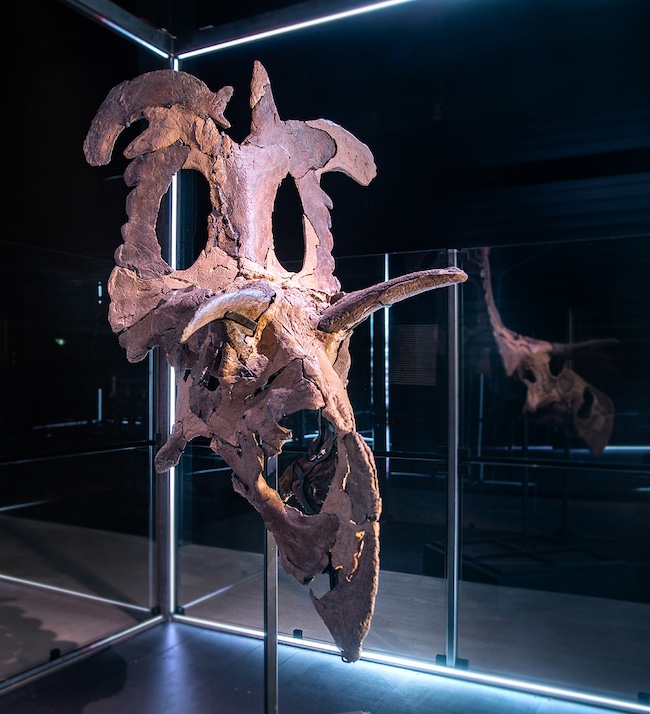
Reconstructing Lokiceratops
They found the new dinosaur in the arid badlands of northern Montana. However, 78 million years ago, this area was a very different place. The climate was much warmer. A large sea divided eastern and western North America. The western North American landmass was named Laramidia. Here, Lokiceratops and other creatures lived in swamps and floodplains along the eastern coast of Laramidia. Since then, there have been tremendous changes over geologic time as the climate cooled, sea level lowered and the Rocky Mountains emerged.
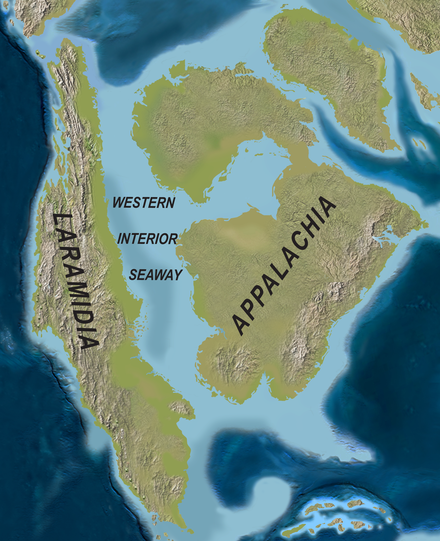
They recovered a partial skeleton of Lokiceratops, found in many pieces: most of the skull, part of a leg, sections of the pelvis and tail bone. The bones went to a lab for processing and study. They made casts – or replicas – of the fossil pieces for further analysis.
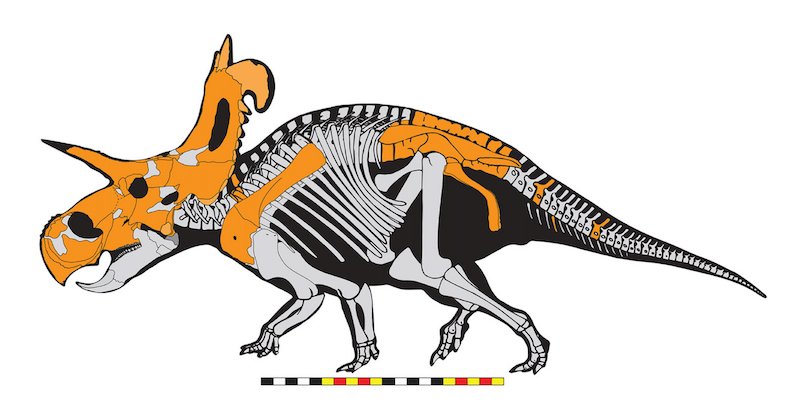
They assembled the skull like a large 3-dimensional jigsaw puzzle. In some sections, missing pieces on one side of the skull were reconstructed using polyester resin based on existing bone on the other side. It wasn’t until they pieced the skull together that the scientists realized they were face to face with a new dinosaur species.
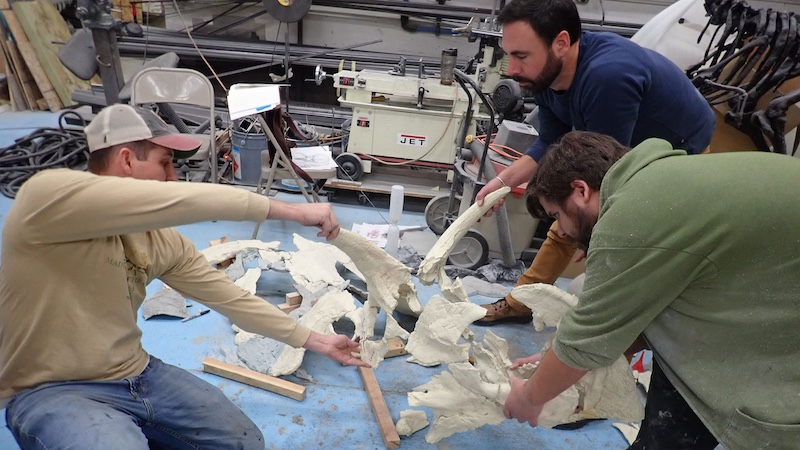
Lokiceratops’ place in understanding Ceratopsian evolution
In this video, Mark Loewen discussed the significance of Lokiceratops rangiformis and the scientists’ analysis of Ceratopsian dinosaur fossils.
Three other closely-related Ceratopsians (horned plant-eating dinosaurs with frills) had also been found in the vicinity of Lokiceratops, as well as another related Ceratopsian. They evacuated those fossils from the same band of sediment as Lokiceratops. This indicated that five different Ceratopsians lived at the same time in the area. They were identified as different species by the shapes of their horns and frills.
Loewen said:
Previously, paleontologists thought a maximum of two species of horned dinosaurs could coexist at the same place and time. Incredibly, we have identified five living together at the same time. The skull of Lokiceratops rangiformis is dramatically different from the other four animals it lived alongside.
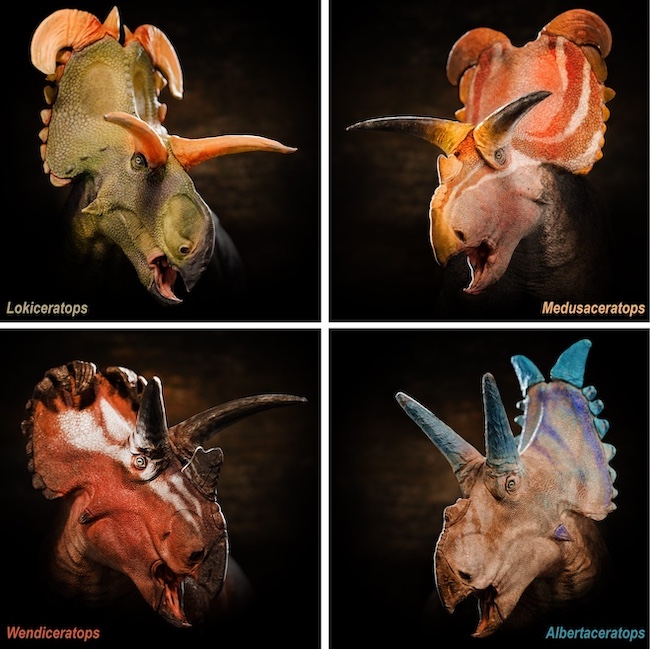
Ceratopsian dinosaur diversity in Laramidia
Scientists think that geographic isolation of Ceratopsians in Laramidia drove the evolution of large body sizes, and the ornate horns and frills. They suggest that, perhaps, sexual selection influenced Ceratopsian evolution. Each species’ unique headgear affected how the animals recognized each other and their preferences for mates. Their analysis also suggested that these dinosaurs, at that time, were evolving at a higher rate compared to other groups of dinosaurs.
Sertich commented:
We think that the horns on these dinosaurs were analogous to what birds are doing with displays. They’re using them either for mate selection or species recognition.
Sertich also said that 12 million years later, by the time Triceratops appeared, these different species in different locations had been reduced to just two species of horned dinosaurs. It was possibly due, he suggested, to a more homogenous climate.
Loewen remarked:
Lokiceratops helps us understand that we only are scratching the surface when it comes to the diversity and relationships within the family tree of horned dinosaurs.
Bottom line: A new species of plant-eating dinosaur, named Lokiceratops rangiformis, was discovered in northern Montana. This creature, with elaborate horns and frills, lived 78 million years ago.











